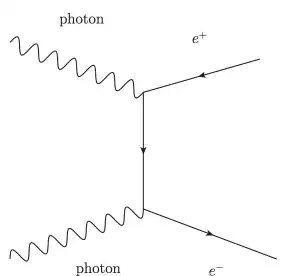Most of you (not me) know that virtual particles are only a nickname for some perturbation terms. So my question is how these perturbations become particles at the edge of an event horizon to create Hawking's radiation. Is there some mechanism that we know from current theories (other than "the energy has to somehow come from the gravitational field") or we will have to wait for a full understanding of quantum gravity? What has to specifically change in that perturbation to change its status from virtual to real? How do they get the energy?
1 Answers
Is there some mechanism that we know from current theories (other than "the energy has to somehow come from the gravitational field") or we will have to wait for a full understanding of quantum gravity?
What are virtual particles? They appear in the mathematics of quantum field theory, in the iconal representation of the integrals necessary to calculate any physical process. Take this simple Feynman diagram , a higher order one, which shows the two photon interaction. Integrating the integrals it represents it gives the probability of two photons interacting in a scattering mode.
The squiggly lines represent the incoming photons and are called real because they represent a specific measurement of two photons of energy E=h*nu scattering off each other, and the two outgoing photons after the interaction, which also are measurable. The calculation of the diagram will give the probability distribution of the measurable quantities of the outgoing photons, given the initial energies and directions of the incoming photons.
The solid loop line represents a virtual electron . It is called virtual because it does not have a definite energy and momentum because it is under the limits of integration, so it is off mass shell, its four momementum does not have the invariant mass of the electron. It is called electron because it has all the quantum numbers of the electron, spin, lepton number. There is also a propagator under the integral which does have the mass of the electron. The virtual electron has a "measurable" existence only at second hand, in the way it affects the integration.
If the energy of the incoming photons is more than twice the mass of an electron, a gamma gamma collision can create two particles :
Compare the two diagrams, the extra energy has "cut" the top diagram's loop of virtual electron, and it represents the creation of a real e+e- pair .
Hypothetically, due to the Heisenberg uncertainty principle (HUP), one can populate the vacuum with innumerable virtual particle loops, but these make no physical sense as the integral over the lone loop is zero, unless there exists a real particle to provide energy for the reaction. As the real gammas extra energy,gives mass to the e=e-, in the lower diagram.
So the mechanism exists due to the HUP. Black holes are a classical General Relativity construct/model. In classical relativity nothing leaves a black hole. In principle , we need a full understanding of quantum gravity to get a definitive model with Feynman diagrams,(which diagrams are the domain where virtual particles can be defined).
BUT Effective quantization of gravity exists, and is used in cosmological models extensively. So the explanation of Hawking radiation is that gravitons will provide the energy to the virtual loops next to the event horizon, allowing for the break up into two real particles one of which will fall back into the black hole and the other leave.
The expectation is that gravity will be quantized in a single model describing particle interactions, string theories are a good candidate, but no definitive model exists yet.
Have a look at this answer of mine for a background, and the link given there..

